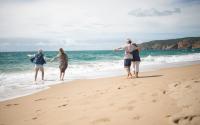Exercise when you’re older
12 June 24
What an interesting and intriguing topic for an organization with such a top-heavy and ageing demographic. It deserves to be fully understood and options explored before we draw any conclusions.
By MW Bro Dr G. Levenston PGM & Dr J. Skowno
If Covid has taught us anything about Freemasonry, it has shown the importance of our twin pillars of positivity and connectedness, both inherently supporting the premise of the topic.
So let’s take that first regular step on our exercise journey.
Back in 2008, Freemasonry, led by this Jurisdiction, actually ran a national men’s health program, for 3 years, engaging with more than 500,000 Australians establishing basic foundations for better health. The messaging was simple and has continued to resonate today, most of the current ‘heavy lifting’ promoted by the Freemasons’ Foundation for Men’s Health coming out of Adelaide University. The message is for the able and disabled.
And let us remind ourselves of those messages:
1. ‘Pink slip’ your health annually. Find a user-friendly GP.
2. Know your ‘numbers’, such as height, weight, body mass index (BMI), pulse rate, blood pressure, up-to-date blood and urine tests checking on such specifics as blood count, serum iron, lipid profile (fasting), blood sugar level (fasting), a look at liver and kidney function, Vitamin D, prostate specific antigen (PSA), and if you insist, a colonoscopy, a bone density test and an exercise ECG. While you are at it, get your eyes and ears checked too. It would be useful to have a look at your diet as well.
3. Review your polypharmacy.
4. Invest in your greatest asset (your health).
5. And remember, research has shown that it is important for seniors to get all four types of exercise – endurance, strength, balance and flexibility.
So let us look at some definitions.
Exercise – any movement that makes your muscles work and requires your body to burn calories. The Government recommendation is for 150 minutes of moderate-intensity activity a week spread evenly over 4–5 days per week. For the over 65s at least two sessions a week that strengthen muscles.
Ageing – ageing is a pattern of life changes that occurs as you grow older.
It is a collective process at a number of levels including:
- Biological age
- Psychological age
- Social age
- Legal age
- Functional age
What is chronological age versus biological age?
Chronological age is your exact age from birth.
Biological age is determined by physiology rather than chronology and Functional age is in terms of functional performance.
With your annual ‘pink slip’ you will be able to determine what level of functional performance you can safely achieve. Everyone is different and unique but exercising with a peer group is important.
There are many benefits to exercising and let us focus on the major ones.
1. Direct benefits in the brain:
- Stimulates growth of new blood vessels
- Reduces insulin resistance
- Reduces inflammation
- Stimulates growth factor
2. Indirect benefits for the brain:
- Improves sleep, mood and self-esteem
- Increases release of endorphins
- Reduces anxiety and stress
- Improves memory and thinking ability
3. Cardiovascular benefits of aerobic exercise:
- Increases cardiovascular capacity and can reduce the risk of sudden cardiac arrest
- Reduces blood pressure
- Consequently, reducing the risk of stroke and vascular dementia
4. Exercise and strength training can reduce the development and consequences of chronic diseases such as:
- Diabetes
- Asthma
- Cancer
- Hypertension
- Cardiovascular disease
- Osteoarthritis
- Osteoporosis
- Better balance and reducing ‘falls’ risk
5. General health benefits:
- Increase in mobility
- Reduction in weight
- Increase in energy levels
- Elevation of mood
- Improvement in the capacity of your immune system (think Covid)
- Improvement in your sex life
So let’s begin; the good news is it’s never too late to START. Change comes slowly. Let’s be positive and let’s consider the type of exercise and how much exercise.
Type of Exercises
- Stand/Sit/Stand
- Warm-up/Stretching/Warm down
- Aerobics/Static bike/Treadmill/Weights
- Walking up to brisk walking. Remember to specifically exercise your feet for balance and proprioception.
- Outdoor bike
- Swimming / Water aerobics
- Pilates
- Yoga
- Join a gym
- Exercise solo or with a group
Make exercise fun and worthwhile
> Remember to monitor your blood pressure and pulse rate. Progress safely.
> Track your ‘numbers’. At the beginning, you should max out with a pulse rate of no more than 120 beats per minute.
Examples of exercise intensity
- Light – slow walking, household chores, washing dishes, cooking
- Moderate – brisk walking, mowing lawn, vacuuming
- Vigorous – jogging, carrying heavy loads, digging in garden
- NB – sitting down doing nothing for more than nine hours per day is associated with higher risk of death
Exercise, across all people and age groups, as medicine, WORKS.
So, take that first step and enjoy the journey of your body and mind.
In conclusion, in a masonic sense, be positive and connect with life.
Extracted from the December 22 Freemason
References:
GP’s, Physio, Dietician, Personal Trainers, family and friends’ support, NSW Government Step Program Local Council e.g. walking groups, gardening groups etc. Freemason’s Foundation for Men’s Health: www.fcmhw.org.au Local parks, streets, swimming pools NSW ‘Active & Healthy’ website, apply for a printed copy of Staying Active and on your Feet booklet ‘WHO’ guidelines for better health International Exercise Recommendations for Older Adults (ICFSR) Springer Link ‘BEAT IT’ program PHN, Sydney North Health Network, health, ageing and reconditioning Fitness Australia – ausactive.org.au


